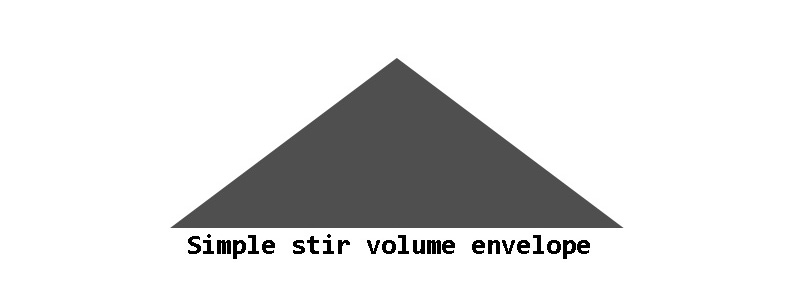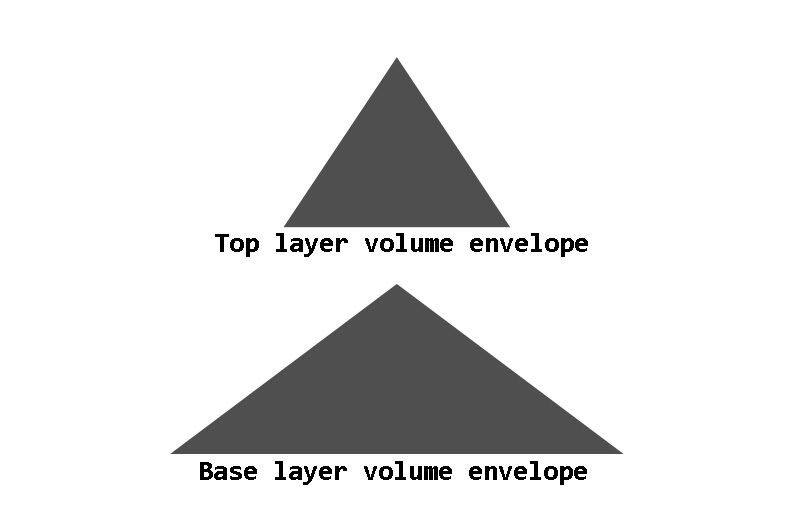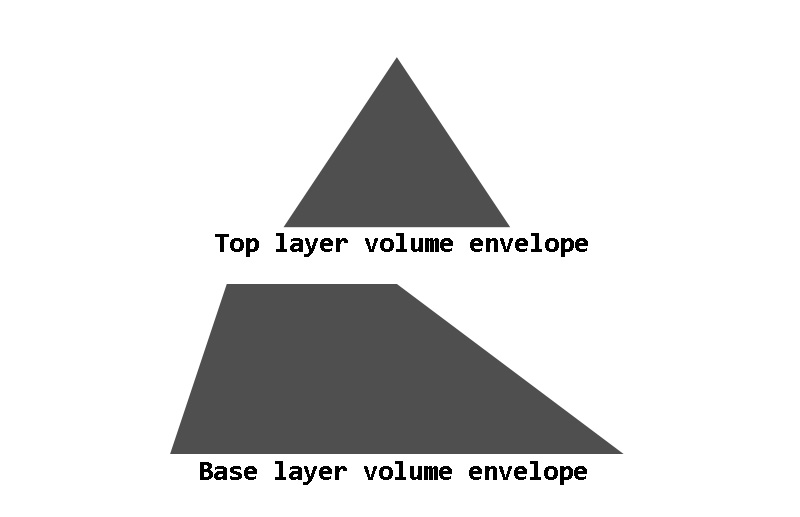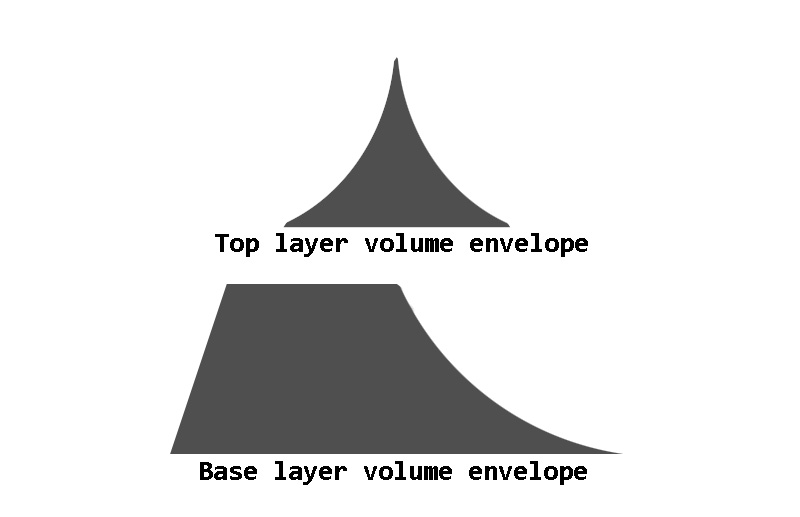Brush stirs
Not all drum sounds are hits which can be used in the usual way described in our drum basics article. One major exception are brush techniques which involve scraping the brush across a drum head, often in a circle. If you are not sure what this looks or sounds like, this video is a good guide. These techniques are called swirls or stirs, and for the purpose of this article we’ll call them stirs. As the sound changes in intensity, and the duration of the scrapes needs to fit the tempo and rhythm of the song, sampling them requires a different approach to the usual drum hits. The two common approaches are to completely ignore this technique and not sample it at all, and to record loops to fit various tempos.
This article describes another approach. The key principle here is that stirs are a noisy, nonlinear sound with a lot of randomness, which makes them very easy to crossfade or loop with no phase issues. Therefore, instead of trying to record stirs performed in a realistic way, we propose recording long, unrealistically steady stirs with no perceptible rhythm or expression, and then using those samples as source material for building up a musical stir.
Recording the source material #
For the purposes of this example, let’s assume the source stirs are recorded at four speeds, with 1 being the slowest and 4 being the fastest. Speed 1 is slow enough that a full circle around the head of the drum is completed in more than 4 seconds. That’s enough to fill a measure at 60 bpm and still have some sound left, so the user can start the next stir before the previous one ends, and thus achieve a continuous sound. Speed 4 is several circles per second, to match the speed at which the brush would be moving during the peak of an aggressive stir. Making the sound steady at this speed is a challenge.
As for how long the recordings need to be, speed 1 needs to be long enough for the longest stir we want to be able to make. However, if tuning controls are to be applied, it’s important to remember that pitching a sample up shortens it, so if the tuning range is to extend to one octave up, then a 10-second sample is the minimum to make a 5-second stir. Speeds 3 and 4 are not used thorughout the duration of a stir but only for peaks, and for the purposes of this example they can be half the length of speed 1.
Simple stir model #
We can make a very simple stir using speed 1 by playing the sample with loop_mode set to one_shot, like we normally would set it for a drum hit, and using a simple volume envelope to fade this sample in over a time, and then fade it out.
<region>key=26 loop_mode=one_shot
sample=snare_stir_speed_1.wav
ampeg_attack=1.0 ampeg_decay=1.0 ampeg_sustain=0
The resulting volume envelope will look something like this. The illustrations are not precise, only general shapes.

This is a good start, and we can add expression and realism by layering a faster speed on top of it near the stir’s peak, with half the duration of the base layer. We use ampeg_delay to delay the start of the second layer by the same amount, so the peaks of both layers align in time.
<region>key=26 loop_mode=one_shot
sample=snare_stir_speed_1.wav
ampeg_attack=1.0 ampeg_decay=1.0 ampeg_sustain=0
<region>key=26 loop_mode=one_shot
sample=snare_stir_speed_3.wav
ampeg_delay=0.5 ampeg_attack=0.5 ampeg_decay=0.5 ampeg_sustain=0

Modulating stir duration #
This has a fixed duration and is not flexible, but the stir length can easily be modulated by a single CC parameter changing all the envelope durations. Extremely short stirs, lasting only a small fraction of a second, are obviously not going to sound realistic, so we can use a minimum value to prevent that. Let’s use CC1 (standard mod wheel).
<region>key=26 loop_mode=one_shot
sample=snare_stir_speed_1.wav
ampeg_attack=0.1 ampeg_decay=0.1 ampeg_sustain=0
ampeg_attackcc1=0.4 ampeg_decaycc1=0.4
<region>key=26 loop_mode=one_shot
sample=snare_stir_speed_3.wav
ampeg_delay=0.05 ampeg_attack=0.05 ampeg_decay=0.05 ampeg_sustain=0
ampeg_delaycc1=0.25 ampeg_attackcc1=0.25 ampeg_decaycc1=0.25
Making the shape more realistic #
Drummers testing the above model have asked for some adjustments to make it sound more realistic. One is to make the first half of the base layer steadier. This can be done very easily by shortening the attack and adding a hold time to the envelope, ensuring that they still add up to the same amount of time that the faster layer’s delay and attack, so the peak will remain aligned at all values of the modulation parameter. The attack stage should generally be shorter than the hold stage.
<region>key=26 loop_mode=one_shot
sample=snare_stir_speed_1.wav
ampeg_attack=0.05 ampeg_hold=0.05 ampeg_decay=0.1 ampeg_sustain=0
ampeg_attackcc1=0.05 ampeg_holdcc1=0.35 ampeg_decaycc1=0.4
<region>key=26 loop_mode=one_shot
sample=snare_stir_speed_3.wav
ampeg_delay=0.05 ampeg_attack=0.05 ampeg_decay=0.05 ampeg_sustain=0
ampeg_delaycc1=0.25 ampeg_attackcc1=0.25 ampeg_decaycc1=0.25

Also, the peak should be sharper and more accented than it is with linear envelopes. Changing the envelope curves accomplishes this, though the initial attack envelope of the base layer can remain linear. The below values seem like a decent start.
<region>key=26 loop_mode=one_shot
sample=snare_stir_speed_1.wav
ampeg_attack=0.05 ampeg_hold=0.05 ampeg_decay=0.1 ampeg_sustain=0
ampeg_attackcc1=0.05 ampeg_holdcc1=0.35 ampeg_decaycc1=0.4
ampeg_attack_shape=0.0 ampeg_decay_shape=-1.4
<region>key=26 loop_mode=one_shot
sample=snare_stir_speed_3.wav
ampeg_delay=0.05 ampeg_attack=0.05 ampeg_decay=0.05 ampeg_sustain=0
ampeg_delaycc1=0.25 ampeg_attackcc1=0.25 ampeg_decaycc1=0.25
ampeg_attack_shape=3.5 ampeg_decay_shape=-1.4

Adjusting the envelope shapes #
The above fixed envelope shapes are good for medium tempos and energy levels, but for slow tempos the flat envelope shapes actually work quite well, and more energetic tracks might sound better with even sharper envelope peaks. It would be nice to adjust the envelope curve shapes with MIDI CC, but it is not currently possible to do this. It’s possible to work around this by crossfading sharp-envelope and flat-envelope regions, or use locc/hicc to select between several pre-baked envelope shapes. Here’s an example of the latter method.
<group>key=26 loop_mode=one_shot
<region>hicc100=42
sample=snare_stir_speed_1.wav
ampeg_attack=0.05 ampeg_hold=0.05 ampeg_decay=0.1 ampeg_sustain=0
ampeg_attackcc1=0.05 ampeg_holdcc1=0.35 ampeg_decaycc1=0.4
ampeg_attack_shape=0.0 ampeg_decay_shape=0.0
<region>hicc100=42
sample=snare_stir_speed_3.wav
ampeg_delay=0.05 ampeg_attack=0.05 ampeg_decay=0.05 ampeg_sustain=0
ampeg_delaycc1=0.25 ampeg_attackcc1=0.25 ampeg_decaycc1=0.25
ampeg_attack_shape=0.0 ampeg_decay_shape=0.0
<region>locc100=43 hicc100=86
sample=snare_stir_speed_1.wav
ampeg_attack=0.05 ampeg_hold=0.05 ampeg_decay=0.1 ampeg_sustain=0
ampeg_attackcc1=0.05 ampeg_holdcc1=0.35 ampeg_decaycc1=0.4
ampeg_attack_shape=0.0 ampeg_decay_shape=-1.4
<region>locc100=43 hicc100=86
sample=snare_stir_speed_3.wav
ampeg_delay=0.05 ampeg_attack=0.05 ampeg_decay=0.05 ampeg_sustain=0
ampeg_delaycc1=0.25 ampeg_attackcc1=0.25 ampeg_decaycc1=0.25
ampeg_attack_shape=3.5 ampeg_decay_shape=-1.4
<region>locc100=87
sample=snare_stir_speed_1.wav
ampeg_attack=0.05 ampeg_hold=0.05 ampeg_decay=0.1 ampeg_sustain=0
ampeg_attackcc1=0.05 ampeg_holdcc1=0.35 ampeg_decaycc1=0.4
ampeg_attack_shape=0.0 ampeg_decay_shape=-3.5
<region>locc100=87
sample=snare_stir_speed_3.wav
ampeg_delay=0.05 ampeg_attack=0.05 ampeg_decay=0.05 ampeg_sustain=0
ampeg_delaycc1=0.25 ampeg_attackcc1=0.25 ampeg_decaycc1=0.25
ampeg_attack_shape=5.2 ampeg_decay_shape=-3.5
Adding ornaments #
So far, we have a stir with adjustable duration and shape which peaks halfway through. More complex patterns can have more than one peak, though. A simple way to emulate that is to use a differnet MIDI note to trigger short ornaments which will add a brief extra sound to the stir, thus emulating a momentary acceleration of the brush. We can use one of the higher stir speeds for this.
<group>key=27 loop_mode=one_shot sample=snare_stir_speed_2.wav
ampeg_attack=0.05 ampeg_decay=0.05 ampeg_sustain=0
ampeg_attackcc1=0.2 ampeg_decaycc1=0.2
<region>hicc100=42
ampeg_attack_shape=0.0 ampeg_decay_shape=0.0
<region>hicc100=42
ampeg_attack_shape=3.5 ampeg_decay_shape=-1.4
<region>hicc100=42
ampeg_attack_shape=5.2 ampeg_decay_shape=-3.5
Accents #
We can also create accents, which are similar to the typical stir but peak much more quickly and use faster speeds. In pracitce, they can be used either as short, aggressive stirs, or added on top of basic stirs to create more complex patterns. The difference in the SFZ here is that the attack curve shape can be applied to the attack portion as well, and there is no hold stage in the envelope.
<group>key=28 loop_mode=one_shot
<region>hicc100=42
sample=snare_stir_speed_2.wav
ampeg_attack=0.05 ampeg_decay=0.1 ampeg_sustain=0
ampeg_attackcc1=0.05 ampeg_decaycc1=0.4
ampeg_attack_shape=0.0 ampeg_decay_shape=0.0
<region>hicc100=42
sample=snare_stir_speed_4.wav
ampeg_attack=0.05 ampeg_decay=0.05 ampeg_sustain=0
ampeg_attackcc1=0.05 ampeg_decaycc1=0.2
ampeg_attack_shape=0.0 ampeg_decay_shape=0.0
<region>locc100=43 hicc100=86
sample=snare_stir_speed_2.wav
ampeg_attack=0.05 ampeg_decay=0.1 ampeg_sustain=0
ampeg_attackcc1=0.05 ampeg_decaycc1=0.4
ampeg_attack_shape=3.5 ampeg_decay_shape=-1.4
<region>locc100=43 hicc100=86
sample=snare_stir_speed_4.wav
ampeg_attack=0.05 ampeg_decay=0.05 ampeg_sustain=0
ampeg_attackcc1=0.05 ampeg_decaycc1=0.2
ampeg_attack_shape=3.5 ampeg_decay_shape=-1.4
<region>locc100=87
sample=snare_stir_speed_2.wav
ampeg_attack=0.05 ampeg_decay=0.1 ampeg_sustain=0
ampeg_attackcc1=0.05 ampeg_decaycc1=0.4
ampeg_attack_shape=5.2 ampeg_decay_shape=-3.5
<region>locc100=87
sample=snare_stir_speed_4.wav
ampeg_attack=0.05 ampeg_decay=0.05 ampeg_sustain=0
ampeg_attackcc1=0.05 ampeg_decaycc1=0.2
ampeg_attack_shape=5.2 ampeg_decay_shape=-3.5
Muting #
As all the above sounds have loop_mode set to one_shot, triggering a note causes the sound to play until the volume envelope drops to zero. If ending a stir earlier than that is required, we can use polyphony groups. The group and off_by opcodes are the key ones here. We can use them to make stirs self-mute, so that triggering a new stir will mute any previously playing stirs, as well as add a key which produces no sound, using silence instead of a sample, but is in the same mute groups, so triggering this key will mute any stir or accent currently playing. This key can be used to stop stirs early.
Note that, as usual, separate groups are needed for layers which are to play simultaneously, and if there are multiple microphone positions then those would need separate groups as well. In the below example we also have stirs mute accents, and vice versa, although the ornaments are left out of the mute groups and can be layered on top of other sounds without muting them. For a more sophisticated use of mute groups with other pieces of the drum kit, please see cymbal muting.
<global>loop_mode=one_shot off_mode=normal
ampeg_release=0.1 ampeg_releasecc1=0.2
<group>key=26
<region>hicc100=42
sample=snare_stir_speed_1.wav
ampeg_attack=0.05 ampeg_hold=0.05 ampeg_decay=0.1 ampeg_sustain=0
ampeg_attackcc1=0.05 ampeg_holdcc1=0.35 ampeg_decaycc1=0.4
ampeg_attack_shape=0.0 ampeg_decay_shape=0.0
group=1 off_by=1
<region>hicc100=42
sample=snare_stir_speed_3.wav
ampeg_delay=0.05 ampeg_attack=0.05 ampeg_decay=0.05 ampeg_sustain=0
ampeg_delaycc1=0.25 ampeg_attackcc1=0.25 ampeg_decaycc1=0.25
ampeg_attack_shape=0.0 ampeg_decay_shape=0.0
group=2 off_by=2
<region>locc100=43 hicc100=86
sample=snare_stir_speed_1.wav
ampeg_attack=0.05 ampeg_hold=0.05 ampeg_decay=0.1 ampeg_sustain=0
ampeg_attackcc1=0.05 ampeg_holdcc1=0.35 ampeg_decaycc1=0.4
ampeg_attack_shape=0.0 ampeg_decay_shape=-1.4
group=1 off_by=1
<region>locc100=43 hicc100=86
sample=snare_stir_speed_3.wav
ampeg_delay=0.05 ampeg_attack=0.05 ampeg_decay=0.05 ampeg_sustain=0
ampeg_delaycc1=0.25 ampeg_attackcc1=0.25 ampeg_decaycc1=0.25
ampeg_attack_shape=3.5 ampeg_decay_shape=-1.4
group=2 off_by=2
<region>locc100=87
sample=snare_stir_speed_1.wav
ampeg_attack=0.05 ampeg_hold=0.05 ampeg_decay=0.1 ampeg_sustain=0
ampeg_attackcc1=0.05 ampeg_holdcc1=0.35 ampeg_decaycc1=0.4
ampeg_attack_shape=0.0 ampeg_decay_shape=-3.5
group=1 off_by=1
<region>locc100=87
sample=snare_stir_speed_3.wav
ampeg_delay=0.05 ampeg_attack=0.05 ampeg_decay=0.05 ampeg_sustain=0
ampeg_delaycc1=0.25 ampeg_attackcc1=0.25 ampeg_decaycc1=0.25
ampeg_attack_shape=5.2 ampeg_decay_shape=-3.5
group=2 off_by=2
<group>key=27 sample=snare_stir_speed_2.wav
ampeg_attack=0.05 ampeg_decay=0.05 ampeg_sustain=0
ampeg_attackcc1=0.2 ampeg_decaycc1=0.2
<region>hicc100=42
ampeg_attack_shape=0.0 ampeg_decay_shape=0.0
<region>hicc100=42
ampeg_attack_shape=3.5 ampeg_decay_shape=-1.4
<region>hicc100=42
ampeg_attack_shape=5.2 ampeg_decay_shape=-3.5
<group>key=28
<region>hicc100=42
sample=snare_stir_speed_2.wav
ampeg_attack=0.05 ampeg_decay=0.1 ampeg_sustain=0
ampeg_attackcc1=0.05 ampeg_decaycc1=0.4
ampeg_attack_shape=0.0 ampeg_decay_shape=0.0
group=1 off_by=1
<region>hicc100=42
sample=snare_stir_speed_4.wav
ampeg_attack=0.05 ampeg_decay=0.05 ampeg_sustain=0
ampeg_attackcc1=0.05 ampeg_decaycc1=0.2
ampeg_attack_shape=0.0 ampeg_decay_shape=0.0
group=2 off_by=2
<region>locc100=43 hicc100=86
sample=snare_stir_speed_2.wav
ampeg_attack=0.05 ampeg_decay=0.1 ampeg_sustain=0
ampeg_attackcc1=0.05 ampeg_decaycc1=0.4
ampeg_attack_shape=3.5 ampeg_decay_shape=-1.4
group=1 off_by=1
<region>locc100=43 hicc100=86
sample=snare_stir_speed_4.wav
ampeg_attack=0.05 ampeg_decay=0.05 ampeg_sustain=0
ampeg_attackcc1=0.05 ampeg_decaycc1=0.2
ampeg_attack_shape=3.5 ampeg_decay_shape=-1.4
group=2 off_by=2
<region>locc100=87
sample=snare_stir_speed_2.wav
ampeg_attack=0.05 ampeg_decay=0.1 ampeg_sustain=0
ampeg_attackcc1=0.05 ampeg_decaycc1=0.4
ampeg_attack_shape=5.2 ampeg_decay_shape=-3.5
group=1 off_by=1
<region>locc100=87
sample=snare_stir_speed_4.wav
ampeg_attack=0.05 ampeg_decay=0.05 ampeg_sustain=0
ampeg_attackcc1=0.05 ampeg_decaycc1=0.2
ampeg_attack_shape=5.2 ampeg_decay_shape=-3.5
group=2 off_by=2
<group>key=29 sample=*silence
<region>group=1 off_by=1
<region>group=2 off_by=2
It is, of course, possible to apply round robins and dynamic layers to this, just like any other drum sound. That is left as an exercise to the reader.
Alternative approach #
The above approach was developed to be playable from an electronic drum kit controller. For keyboard controllers or sequencing, another approach is possible where instead of using a MIDI note to trigger a new stir every time the drummer would complete a circle, we hold down a long note for as long as we want to produce stirs (so, possibly for several measures, or even the entire duration of a song). We then use MIDI CC to crossfade between the layers to modulate the speed of the stir in order to create realism and rhythmic interest. In order to be able to do this, the samples will have to be looped, but as stated at the beginning, looping or crossfading noisy samples is very easy as there are no phase issues. We also set the loop_mode opcode to continuous instead of the one_shot setting used in the earlier approach.
<group>key=26 loop_mode=continuous ampeg_release=0.25
<region>sample=snare_stir_speed_1.wav xfin_locc1=0 xfin_hicc1=31 xfout_locc1=32 xfout_hicc1=63
<region>sample=snare_stir_speed_2.wav xfin_locc1=32 xfin_hicc1=63 xfout_locc1=64 xfout_hicc1=95
<region>sample=snare_stir_speed_3.wav xfin_locc1=64 xfin_hicc1=95 xfout_locc1=96 xfout_hicc1=127
<region>sample=snare_stir_speed_4.wav xfin_locc1=96 xfin_hicc1=127
In practice, this approach has proven more difficult to use, with it being easy to sound obviously unrealistic by moving the MIDI CC parameter too quickly or staying at high values for too long. With care, however, it can produce realistic results, and it is extremely flexible.
Further possibilities #
The brush flutter technique can be treated similarly to the base layer of the stirs. There is no need to layer faster and slower flutters. In theory, this approach could also be extended to other noisy, highly nonlinear sounds which can vary in duration - perhaps shakers. The main challenge there would be to record shakers shaking smoothly for an extended duration.
It is also certainly possible to further improve the above model with more realism and playablity.